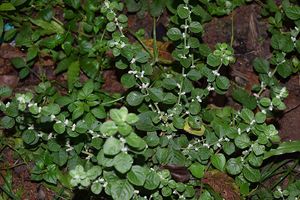Note: This is a project under development. The articles on this wiki are just being initiated and broadly incomplete. You can Help creating new pages.
Rotula aquatica - Ashmahabhedah
Ashmahabhedah or Aerva lanata is a common weed which grows wild everywhere in the plains of India. The root has a camphor-like aroma.[1] The dried flowers which look like soft spikes, are sold under the commercial names as Buikallan or Boor. It is one of the plants included in Dasapushpam, the ten sacred flowers of Kerala.
Uses
migraines, headaches, vomiting, piles, burning sensation, perspiration problems, burning sensation in the vagina.
Parts Used
Chemical Composition
Atisine, Aconitine, Atisenol, Atidine, Hetisine, Hetisinone, Banzolheteratisine, Histidine, F-dihydroatisine, Heteratisine and Several diterpene alkaloids such aheterophyllin, heterophyllisin, heterophyllidine, and hetidine.[2]
Common names
| Language | Common name |
|---|---|
| Kannada | Bilesuli |
| Hindi | Gorakhbuti or Kapuri jadi |
| Malayalam | Cherula |
| Tamil | Sirru -pulay -vayr |
| Telugu | Pindi-kura |
| Marathi | NA |
| Gujarathi | NA |
| Punjabi | NA |
| Kashmiri | NA |
| Sanskrit | Astmabayda |
| English | Indian Atees |
Habit
Identification
Leaf
| Kind | Shape | Feature |
|---|---|---|
| glabrous | sessile | The leaves are variable in shape and size |
.[3]
Flower
| Type | Size | Color and composition | Stamen | More information |
|---|---|---|---|---|
| Unisexual | 2-4cm long | white–violet | 10-18 | Flowers are Large, hooded and occur in slender racemes or lax leafy panicles. Corolla is hairy. Carpels are five in number |
Fruit
| Type | Size | Mass | Appearance | Seeds | More information |
|---|---|---|---|---|---|
| 7–10 mm (0.28–0.4 in.) long pome | s | {{{6}}} |
Other features
List of Ayurvedic medicine in which the herb is used
- Vishatinduka Taila as root juice extract
Where to get the saplings
Mode of Propagation
How to plant/cultivate
The more common species of Aconitum are generally those cultivated in gardens, especially hybrids. They typically thrive in well-drained evenly moist garden soils like the related hellebores and delphiniums, and can grow in the shade of trees.[4]
Commonly seen growing in areas
Photo Gallery
References
- ↑ Cite error: Invalid
<ref>tag; no text was provided for refs namedcommon - ↑ "medicinal plants"
- ↑ "bimbima"
- ↑ "wikipedea"
External Links
- Pages with reference errors
- Pages that are stubs
- Ayurvedic Herbs known to be helpful to treat migraines
- Ayurvedic Herbs known to be helpful to treat headaches
- Ayurvedic Herbs known to be helpful to treat vomiting
- Ayurvedic Herbs known to be helpful to treat piles
- Ayurvedic Herbs known to be helpful to treat burning sensation
- Ayurvedic Herbs known to be helpful to treat perspiration problems
- Ayurvedic Herbs known to be helpful to treat burning sensation in the vagina
- Herbs with Root tubers used in medicine
- Herbs with common name in Kannada
- Herbs with common name in Hindi
- Herbs with common name in Malayalam
- Herbs with common name in Tamil
- Herbs with common name in Telugu
- Herbs with common name in Sanskrit
- Herbs with common name in English
- Habit - Herb
- Index of Plants which can be propagated by Seeds
- Index of Plants which can be propagated by Tuber segment
- Herbs that are commonly seen in the region of eastern trophical area
- Herbs that are commonly seen in the region of southern trophical
- Herbs that are commonly seen in the region of western trophical



